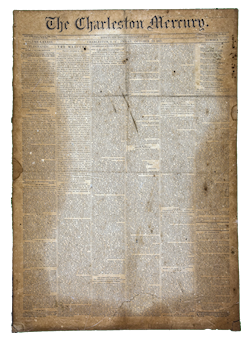April 13, 1863, The New York Herald
UNITED STATES TRANSPORT GEORGE PEABODY,
AT SEA, April 10, 1863.
We arrived at Port Royal on the morning of the 9th, and found, to our great satisfaction, that the movement towards the capture of Charleston began on the afternoon of the 7th instant by the iron-clads, which went up the harbor for the purpose of testing their guns and drawing the fire of the enemy. A portion of the iron-clads went up as an advance squadron to feel the way, and at about two o’clock all of the iron vessels were engaged, while Forts Sumter, Moultrie and the batteries on Sullivan’s and Morris’ islands opened with a terrific fire and with a remarkable degree of precision.
The harbor was literally enveloped in smoke, while the thundering of artillery and the booming of the fifteen inch guns were truly awful – a real feu d. The major portion of the fire of our iron-clads was directed at Fort Sumter, which replied in salvos and with great rapidity, the shot frequently striking the iron-clads. The New Ironsides blazed away fiercely, at times being entirely wrapped in smoke, while lurid sheets of flame were continually emitted from her sides.
The Monitor batteries fired their guns very rapidly for such heavy ordnance, while the Keokuk, with her eleven-inch guns, threw in shell in fine style.
At about four o’clock the New Ironsides, with Admiral Du Pont on board, dropped down the channel, and shortly afterwards the Keokuk was injured, it is said by a torpedo exploding under her bottom. The rebels made her the especial mark of their guns, and during the time she was under fire it is said that no less than sixty shots penetrated her armor; but only one man was killed. As soon as it was found that she was injured Captain Rhind withdrew his vessel and grounded her on the Morris Island beach, where she now lies, a total wreck.
The Monitor batteries stuck to their ground until about five o’clock, when, owing to the tide falling and night coming on, they withdrew out of range, the enemy firing at them with renewed vigor until out of the reach of their guns.
The Nahant was struck, it is said, five hundred times; but no damage was done to the vessel, except knocking out some of the bolts in the pilothouse and turret and injuring one of the gunslides slightly. All the damage done to her can be repaired in forty-eight hours. Her smokestack was completely riddled. The other vessels received their due share of hammering; but all withstood it elegantly and are again ready for service.
The Nahant was towed to Port Royal, arriving off the bar at daylight on the morning of the 9th. As soon as this bar was reached the towlines were cast off, and she steamed up the harbor alone, and to the eye of a casual observer uninjured although her turret and smokestack bear unmistakable signs of the heavy fire she had been subjected to from the rebel batteries.
During the engagement on the afternoon of the 7th our iron-clads were so near to the city of Charleston that their two hundred-pounder Parrott guns could with ease have landed shells in it; but as the movement was only intended as a preliminary one to the grand attack, Admiral Du Pont would not permit the city to be troubled at that time. The rebel iron-clads Palmetto State and Chicora were in sight, and tried the range of their guns, but did not attempt to make use of their boasted powers as rams; and it was not until our iron-clads retired that they came out fairly from behind the walls of Sumter.
The fleet of wooden vessels were not engaged in these preliminary operations, as it was not thought best to expose them before a general attack was made.
After taking the mails on board at Port Royal, we steamed up to Charleston bar, with orders to report to General Hunter, who was on board of the steamer Ben Deford. On our arrival there we were informed that the General had gone up the harbor that afternoon, and it being dark and among a large fleet of vessels, the gunboats cruising off the bar ordered us to proceed on our voyage without delay.
From these vessels we learn that every one was in the best possible spirits, and that all our plans and operations were working equal to the expectations of all concerned.
A rumor was in circulation, both at Port Royal and at Charleston bar, that our troops were rapidly gaining the rear of the city of Charleston.
A government despatch boat sailed for Hampton Roads on the 8th, carrying a bearer of despatches.
As we left Port Royal harbor we passed a small steamer having on board the newspaper reporters, whose letters will go North in the Arago, on Saturday. We were not able to communicate with them.
The following is a list of officers of the iron-clad Keokuk, which was destroyed by the rebels in the attack on the Charleston forts on the 7th inst: –
Commander – A. C. Rhind.
Executive Officer – Moreau Forrest.
Acting Paymaster – John Read.
Surgeon – Geo. D. Slocum.
Acting Ensigns – Wm. H. Bullis, Alex. McIntosh, Isaac T. Halstead.
Engineers – Chief, Wm. H. King; Assistants, John H. Hunt, Wm. H. Smith, J. M. Emanuel, W. H. G. West.
The following is a list of officers of the Monitor battery Nahant, which was slightly injured in the engagement of the 7th inst., at Charleston: –
Commander – John Downes.
Lieutenant Commander – D. B. Harmony.
Acting Master – Wm. W. Carter.
Acting Ensign – Charles E. Clark, Charles C. Ricker.
Assistant Surgeon – C. E. Stedman.
Assistant Paymaster – Edwin Putnam.
Engineers – First Assistant, F. J. Lovering; Second Assistant, T. H. Bordley; Third Assistants, Abram Michner, William S. Neil.
Pilot – Isaac Sofield.
